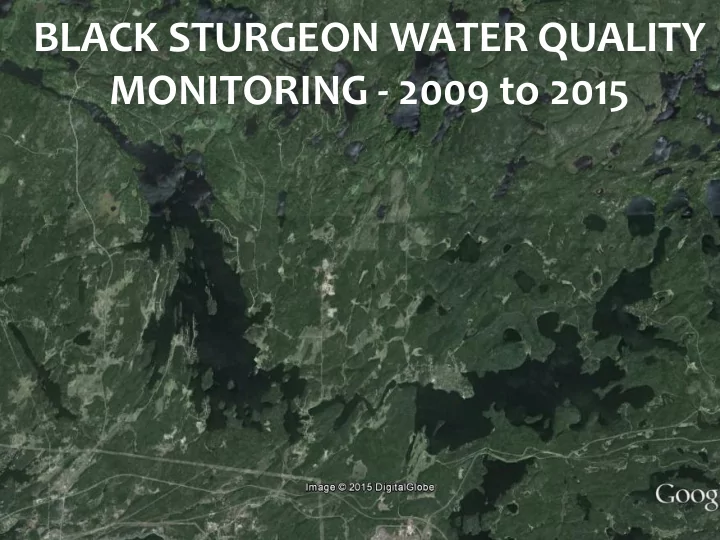

BLACK STURGEON WATER QUALITY MONITORING - 2009 to 2015
Summary of 2015 Results Lower Black Sturgeon Lake results within provincial water quality objectives for all parameters
Why monitor water quality? All Canadian Shield lakes are getting more eutrophic (shallower, more productive) over time. This is a natural process. However, we want to make sure that human impacts are not accelerating the process (cultural eutrophication). Phosphorous and water clarity are two common parameters used to determine if cultural eutrophication is taking place.
Why Phosphorous?
LAKE 226 – 1973 Carbon, Nitrogen, and Phosphorous
Methodology - Phosphorous - 10 Sampling Sessions - Samples sent to laboratory in Winnipeg for analysis
Results – Site 2 Phosphorous Turnover Concentrations 0.025 0.02 PWQO Phosphorous (mg/L) 0.015 2009 2010 0.01 2015 0.005 0 Spring Turnover Fall Turnover
Phosphorous Concentrations - 2002 to 2015 MOE, Lake Partner Program, City of Kenora 25 20 PWQO 15 10 MOE LPP CK 5 0 2002 2003 2004 2005 2006 2007 2009 2010 2012 2014 2015
Discussion - Phosphorous Phosphorous concentrations in 2015 were in between those found during the 2009 and 2010 seasons, potentially due to “average” summer (2009 was relatively dry and cool, 2010 was warm and wet).
Why Secchi Depth? Measure of water clarity and light penetration Previous data from Lake Related to algal growth Partner Program
Methodology - Secchi Depth
Results – Lower Black Sturgeon Secchi Depths 4.50 4.00 3.50 Secchi Depth (m) 3.00 2.50 LPP 2.00 CK 1.50 1.00 0.50 0.00 1997 1999 2000 2001 2002 2003 2004 2005 2006 2007 2008 2009 2010 2011 2012 2014 2015
Discussion – Secchi Depth Average Secchi depth at Site 2 in 2015 was similar to that found in 2009 and 2010, indicating no significant change (slightly improved) in water clarity over this time period Average Secchi depths found at Site 2 during study years (2009, 2010, and 2015) are all within the range of values found during the 1997 to 2014 Lake Partner Program published results
Additional Data Collected Phosphorous and Secchi Depth data was collected at all three sites (Site 2, Site 3, Site X) during each of the 10 sampling sessions 54 parameters measured as part of spring turnover Water Quality Characteristics laboratory analysis – With no significant changes when compared to 2010 results and all within PWQO where provided DO/Temperature profiles collected for all sites and sampling sessions (including at Site 1 in mid-summer)
Invasive Species – Zebra Mussels Calcium levels need to be at least 8.5 mg/L to support zebra mussels Study results indicate that Calcium concentrations in Black Sturgeon Lakes are less than 6 mg/L There is the potential that zebra mussels may not be able to survive in Black Sturgeon Lakes
Recommendations – Annual Sampling With sampling every five-years, there is the potential that yearly fluctuations will be mistaken for trends over time This could result in both “False Positives” and “False Negatives”
25 20 15 10 5 0 2002 2003 2004 2005 2006 2007 2009 2010 2012 2014
25 20 15 10 5 0 2002 2003 2004 2005 2006 2007 2009 2010 2012 2014
25 20 15 10 5 0 2002 2003 2004 2005 2006 2007 2009 2010 2012 2014
25 20 15 10 5 0 2002 2003 2004 2005 2006 2007 2009 2010 2012 2014
25 20 15 10 5 0 2002 2003 2004 2005 2006 2007 2009 2010 2012 2014
Phosphorous Concentrations - 2002 to 2015 MOE, Lake Partner Program, City of Kenora 25 20 PWQO 15 10 MOE LPP CK 5 0 2002 2003 2004 2005 2006 2007 2009 2010 2012 2014 2015
Recommendations – Annual Sampling It is felt that there is the potential to establish an annual sampling protocol for approximately the same total cost as the current five-year sampling regimen This would help to ensure that trends over time are being monitored and minimize the potential for both “False Positives” and “False Negatives”
Recommend
More recommend